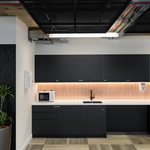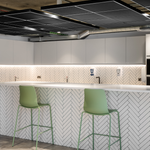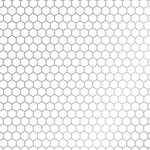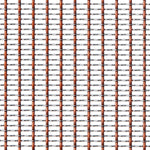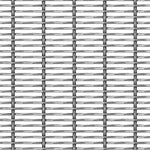You have no items in your shopping cart.
In the world of architecture, construction, and industrial design, expanded mesh stands as a cornerstone material renowned for its versatility and functionality. But what exactly is expanded mesh, and why is it so widely used?
In this comprehensive guide, we'll delve into the intricacies of expanded mesh, exploring its composition, manufacturing process, and diverse applications.
Whether you're a seasoned architect, a budding designer, or simply curious about the world of construction materials, join us as we unravel the mysteries of expanded mesh.
Understanding Expanded Mesh
Expanded mesh, also referred to as expanded metal or expanded metal mesh, represents a remarkable feat of manufacturing ingenuity. Beginning its journey as a flat metal sheet, often composed of aluminum, or mild steel, expanded mesh undergoes a meticulous transformation process. This process involves a sequence of cutting and stretching procedures, meticulously designed to yield a mesh-like structure with interconnected diamond-shaped openings. These meticulously crafted apertures form the hallmark of expanded mesh, endowing it with its distinctive appearance and a plethora of advantageous properties.
The intricate pattern of interconnected diamond-shaped openings not only lends expanded mesh its characteristic aesthetic appeal but also imbues it with a remarkable set of functional attributes. Beyond its visually striking appearance, expanded mesh boasts exceptional strength and durability, making it an ideal choice for a diverse array of applications. Its lightweight nature further enhances its appeal, facilitating ease of handling, transportation, and installation across various projects. Moreover, the interconnected design of expanded mesh allows for superior airflow and ventilation, rendering it invaluable in environments where air circulation is paramount. Additionally, the open structure of expanded mesh facilitates enhanced visibility and light penetration, contributing to dynamic visual effects and reducing reliance on artificial lighting in interior spaces.
Properties and Characteristics

Indeed, the lightweight yet robust nature of expanded mesh sets it apart as a material of exceptional utility and versatility. While boasting remarkable strength akin to solid metal sheets, expanded mesh exhibits a significantly reduced weight, rendering it remarkably easy to handle, transport, and install. This inherent lightweight quality not only streamlines logistical processes but also makes expanded mesh an ideal choice for projects where weight considerations are paramount.
Moreover, the open design of expanded mesh serves as a testament to its adaptability and functionality. By facilitating superior airflow and ventilation, expanded mesh proves invaluable in environments where optimal air circulation is imperative. Whether utilised in building facades, partitions, or industrial applications, the open structure of expanded mesh promotes efficient airflow, ensuring comfort and well-being in both interior and exterior spaces.
Furthermore, the unique properties of expanded mesh extend beyond its functional aspects to encompass its aesthetic appeal. The interconnected diamond-shaped openings not only contribute to the material's distinctive appearance but also play a pivotal role in shaping light and shadow. Through the strategic manipulation of light, expanded mesh creates dynamic visual effects, adding depth and dimension to architectural spaces. By harnessing the natural interplay of light and shadow, expanded mesh reduces reliance on artificial lighting, fostering environments that are both visually captivating and energy-efficient.
Applications and Uses

Expanded mesh is a material of unparalleled versatility, finding a wide range of applications across diverse industries and sectors. Its adaptability and durability make it a go-to choice for architects, designers, and builders alike. Here are some of the key applications of expanded mesh:
-
Mesh Ceilings: Expanded mesh lends itself seamlessly to the creation of striking ceiling designs, offering a unique combination of functionality and aesthetics. Whether used for decorative purposes or to enhance airflow and ventilation, expanded mesh ceilings add a touch of sophistication to any space.
-
Mesh Walls: In both interior and exterior settings, expanded mesh serves as an ideal material for creating visually stunning walls. Whether used as cladding for architectural features or as partitions to delineate spaces, expanded mesh walls offer a blend of privacy, airflow, and design flexibility.
-
External Cladding: Expanded mesh provides an innovative solution for external cladding, offering a durable and visually appealing alternative to traditional materials. Its lightweight yet robust construction makes it ideal for covering large surface areas while allowing for ample airflow and natural light penetration.
-
Furniture: From decorative accents to functional pieces, expanded mesh lends itself to a wide range of furniture applications. Whether used as chair backs or decorative panels, expanded mesh furniture adds a contemporary flair to any interior or exterior space.
-
Safety Barriers: In industrial settings, expanded mesh is often used to create safety barriers and machinery guards. Its sturdy construction and open design provide protection without sacrificing visibility or airflow, ensuring a safe working environment for employees.
-
Filtration Systems: Expanded mesh is also utilised in filtration systems, where its intricate pattern of openings allows for efficient filtration of air, water, or other substances. Its durability and corrosion resistance make it well-suited for use in demanding industrial environments.
-
Sunshades and Sunscreens: Expanded mesh is often used to create sunshades and sunscreens for buildings, providing shading while allowing for airflow and natural light penetration. This helps to reduce solar heat gain and glare, improving comfort levels for building occupants.
-
Green Facades: Expanded mesh can be integrated into green facades to support climbing plants and vegetation. The mesh provides a sturdy structure for plant growth while allowing for air circulation and water drainage, creating a sustainable and visually appealing exterior feature.
-
Balustrades: Expanded mesh is commonly used to create balustrades for staircases, balconies, and terraces. Its open design offers safety without obstructing views, making it a popular choice for modern architectural projects.
-
Signage and Branding: Expanded mesh can be used to create eye-catching signage and branding elements for commercial and retail spaces. Its lightweight yet durable construction allows for the creation of intricate designs and logos, helping businesses to stand out and attract customers.
-
Art Installations: Expanded mesh is a popular choice for artists and sculptors due to its malleability and visual appeal. It can be sculpted, folded, and manipulated to create stunning art installations and sculptures, adding a touch of creativity to public spaces and galleries.
Expanded mesh is a remarkable material that has earned its place as a staple in the world of design and construction. From its intricate diamond-shaped openings to its lightweight yet robust structure, expanded mesh offers a host of benefits that make it indispensable for a wide range of applications. Whether you're designing a modern facade, creating a functional room divider, or enhancing industrial safety measures, expanded mesh provides endless possibilities for innovation and creativity. With its versatility, durability, and aesthetic appeal, expanded mesh continues to shape the built environment and inspire architects, designers, and builders worldwide.



